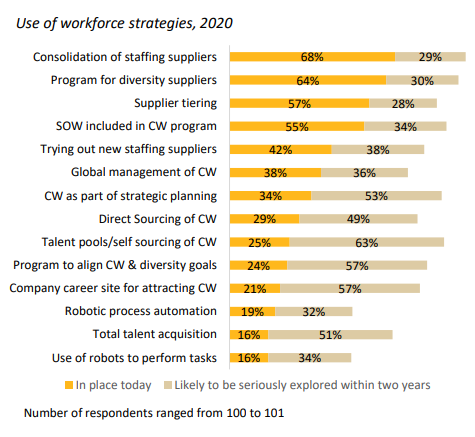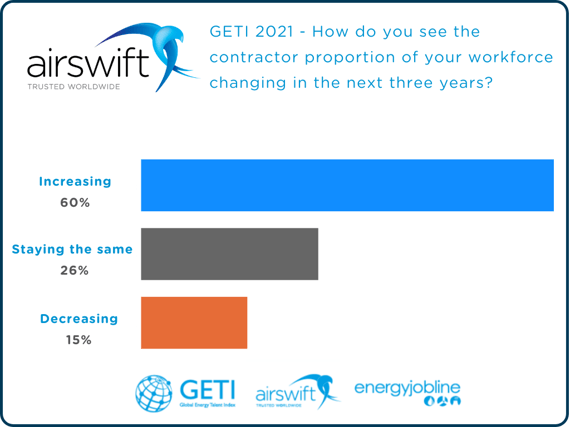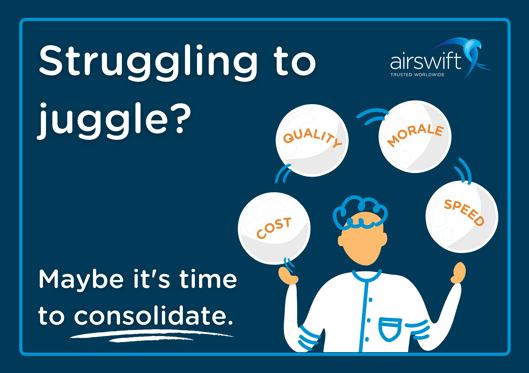
By
Nana Terra
February 22, 2021
Updated
September 9, 2025
Source: Alpa Prod/Shutterstock
Contingent workers have been essential to large technical and engineering projects for several decades
Reduced fixed costs and increased agility, flexibility, and access to specialist talent are key benefits of this approach.
However, many companies are introducing risk and unnecessary spend by using a multitude of agencies and suppliers for their temporary workforce.
With global trends, such as robotics and artificial intelligence, increasing competition for talent - now is the time to ask...
Should you consider consolidating your contingent workforce suppliers?
If you are grappling with increasing personnel costs and fragmented business intelligence. The answer may be yes. Read on to discuss the benefits of adopting a consolidated approach.
Tom Addison, Airswift Media Specialist, discusses the key drivers behind supplier consolidation.
Contingent workforce definition and trends
First, a quick overview of the terminology. In short, contingent work, casual work, or contract work, is a type of employment status where individuals are hired by an organisation on an on-demand basis.
A contingent workforce consists of freelancers, independent contractors, and consultants, who are not on the company's payroll because they are not full-time employees.
The recent Statista Trend Compass found that 79% of executives expect contingent and temporary workers to substantially replace full-time employees in the coming years. That's because using contractors provides a scalable way to achieve their goals. You can improve efficiency and reduce costs with diverse and high-quality workers.
At first glance, it may seem that using a lot of agencies will increase your chance of finding a good candidate.
However, this is a mistake. Quality and efficiency decrease when requisitions are released to more than 20 suppliers, while risk and cost remain about the same.
Why should you consolidate your contingent labour agencies?
According to the Staffing Industry Analysts (SIA) 2020 Workforce Solutions Buyer Survey
- 68% of large companies cited “consolidation of staffing suppliers” as a workforce management strategy currently in place in their organisation.
- 29% said it is a strategy likely to be seriously explored within two years.

Figure 1: Use of workforce strategies, 2020. Source: Staffing Industry Analysts, 2020 Workforce Solutions Buyer Survey
Consolidation needs to occur for outsourcing to be an effective quality and cost savings solution.
The right suppliers can gain a deeper understanding of your future workforce needs. With an integrated approach, they can also prepare proactively - investing time and energy to find the best talent.
Another reason is that a program with a large provider portfolio may likely automatically cap a requisition after a certain number of resumés are submitted. As a result, recruiters will rush to submit candidates - transforming the recruitment process into a speed and numbers game. This will reduce the amount of time to strategically source the best candidates.
Additionally, managing relationships with different points of contact at multiple agencies strains your time management. Each agency will likely charge a different rate as well. This means costs can scale if not properly managed.
All these issues need to be noted, especially in face of a global trend towards flexible workers.
According to the 2021 Global Energy Talent Index (GETI), produced by Airswift in partnership with Energy Jobline, most respondents believe that the contractor proportion of the workforce will increase in the next three years.

Figure 2: How do you see the contractor proportion of your workforce changing in the next three years? Source: GETI Report 2021.
Advantage of consolidating contingent staffing suppliers
Consolidating your contingent labour agency is good for the company and good for the candidates.
It is a strategy that can be adopted by an organisation of any size to
- Improve workforce quality
- Achieve cost savings
- Improve global supply chain management, governance and visibility
- Provide greater business intelligence
- Access live salary benchmarking data
- Increase safety management
- Work with a single point of contact
- Improve contractor performance and retention
- Flexibly scale up or down to meet company goals & objectives.
- Gain a better understanding of global talent pools
Benefits of managing a contingent workforce through a single supplier
-
Less bureaucracy, more flexibility and agility
Workplace flexibility is here to stay.
More and more professionals and companies know the benefits of temporary work and supplier consolidation. That reflects in less bureaucracy and more agility to reduce costs while improving procurement and management processes.
For example, an overreliance on permanent workers could reduce the ability to expand into new markets. A mainly permanent workforce may not be as open to global moves or have the required skills for projects.
-
Monitor your service spend and improve efficiency
With a specialised agency, you can monitor your service spend with clarity, identify skill gaps, and improve efficiency. You need an agency that will work closely with you to build, organise and manage your contingent workforce.
This includes a detailed evaluation of the existing contractor engagement model and a benchmark of contractor rates.
-
Understanding legality and risks
By consolidating your contingent workforce with a specialist, you can analyse recruitment processes and maximise workforce planning.
A single supplier can deliver immediate payback through reduced costs, enhanced productivity, and lower compliance risks.
How do you know that is time to consolidate suppliers?
There are a few indicators that consolidating to a single or small group of suppliers will improve efficiency and reduce costs.
Finance & procurement issues
- You are undertaking a large organisational change, such as mergers, acquisitions or divestment, and need to introduce operational efficiencies.
- One of your major suppliers is going through a transition period or has ceased trading.
- You are paying a wide variety of fees to differing suppliers.
- Procurement of talent is driven by the demands of line managers rather than a centralised procurement team.
Varying service quality
- You have differing onboarding processes and varied levels of service and compliance.
- Processes for managing timesheets differ greatly.
- Issuing requisitions for new hires results in the same individuals being submitted by multiple agencies.
- You have a large contingent workforce and want them to be managed by a single point of contact.
Low morale
- Your contractors are being paid different rates for the same responsibilities.
- There is resentment and low morale within the workforce related to their supplier experience.
- You have misaligned benefits packages.
Operational inefficiency
- You have an agency based in each region rather than using a global firm with presence in all your key locations.
- You have difficulty finding global workers or mobilising talent between locations.
- You have recently won a project in a new location and your existing suppliers are not registered there.
These are a handful of the reasons cited by clients looking to undergo consolidation or a workforce transition, as can be seen in many of our client case studies.
How Airswift can help
Airswift operates in many institutional, economic, political, social, and cultural environments that are in constant and rapid development. Activities, including the transfer of personnel, must be performed in full respect of the law.
It is Airswift’s goal to provide a professional and seamless service to all customers in accordance by all relevant statutory and regulatory requirements. Airswift has extensive experience in the successful transfer of personnel from an incumbent supplier.
Through each transition, our primary objectives are to achieve:
100% Transfer
- Stakeholder engagement
- Personal attention to every contractor
- Added benefits
Zero Disruption
- Incident free transition
- No missed paychecks
- No lapse in benefits
A Positive Impact on Personnel and Clients
- Improved level of contractor care
- Streamlined on-boarding
- Comprehensive reporting mechanisms


